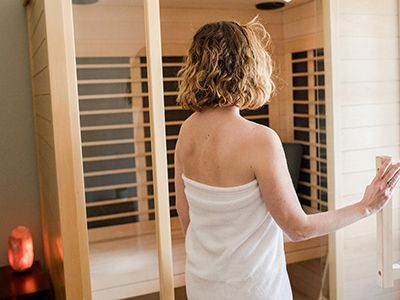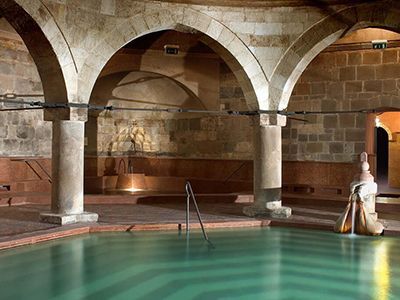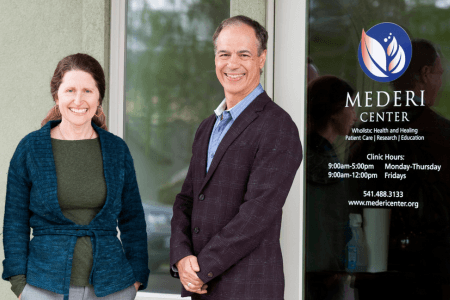Sauna Therapy and Cancer

One of my favorite detoxification strategies is dry (not steam) sauna therapy. There are multiple strategies and approaches for sauna therapy that vary by temperature, heat source, construction quality, time, intensity, and wavelength. Sauna therapy isn’t right for everyone and every circumstance. However, it can have profoundly beneficial health effects when it’s the right tool to use. In my practice, I have found regular sauna therapy to be extremely helpful in most cases of cancer (though there are exceptions to this), and I‘ve seen consistent use significantly improve quality of life, as well as (with proper timing) enhance anti-cancer therapies.
A Brief History of Sauna
Saunas have been used by human beings throughout history, though we don’t know when sauna use began. Most likely, early humans used saunas for warmth and survival in caves. Many ancient rituals involved the use of sauna therapy, and burnt stones thought to have been used for this purpose have been found in many locations by archaeologists.
Throughout Europe, sauna therapy was an integral part of treatment in bath houses. Even the ancient Greeks used sauna therapies within their bath houses. In addition, there’s a significant history of sauna therapy throughout Chinese, Japanese, Korean, and other Asian cultures. Thus, sauna therapy is truly a historically used therapy used by humans worldwide.

Our current understanding of modern saunas comes from Finland, as well as past cultural history of sauna therapy. There are millions of saunas in Finland and many of today’s sauna approaches and research comes from the cold climate of Nordic countries.
Sauna Therapy Explained
In the simplest terms, dry sauna therapy is the therapeutic use of heat. Heat can come to us in many forms and is simply the transfer of thermal energy from one physical system to another. In sauna therapy, this heat is primarily in the form of infrared energy and is thus within a certain wavelength.
In traditional dry saunas when rocks are heated, the primary electromagnetic radiation released is within the infrared spectrum. The infrared spectrum is typically divided into near (NIR), mid (MIR), and far (FIR) infrared, with each directly correlating to specific wavelengths -- short, medium, and long respectively. Each of these wavelengths has specific heating effects on the molecules within the human body.
NIR waves are shorter and thus produce a more intense heat on the surface/skin. This intense heat has shown benefit for skin health and beauty treatments. In addition, near-infrared has been shown to have anti-inflammatory effects, which can help reduce pain and swelling in the body. Near-infrared therapy may also have a positive effect on the immune system by increasing white blood cell production and enhancing the body's ability to fight off infections.
MIR penetrates the body more deeply. MIR is primarily absorbed by the muscles and can help improve circulation by increasing blood flow to the muscles. It has been shown to have a positive effect on joint and muscle pain by reducing inflammation and increasing flexibility. It may also help improve cardiovascular health by increasing heart rate and blood flow.

FIR penetrates the body the deepest. It can penetrate up to 1.5 inches into the body. This makes far-infrared saunas ideal for deep-tissue healing and detoxification. It is primarily absorbed by the adipose tissue (fat cells) and can help promote weight loss by increasing metabolism and burning calories. In addition, FIR has been shown to have a positive effect on the cardiovascular system by reducing blood pressure and improving circulation. Lastly, FIR also helps improve detoxification by increasing sweating and eliminating toxins from the body.
As a whole, saunas can be used very effectively for certain cardiovascular problems and as a means to enhance the mobilization of fat-soluble xenobiotics (foreign substances in the body). When saunas are used to reduce blood pressure and enhance blood flow and cardiac functioning, only short sauna sessions (15 minutes) are necessary. When one wants to enhance the mobilization of heavy metals and chemical xenobiotics, longer sessions are needed and those should be done carefully.
Sauna Therapy and Cancer
Sauna therapy is not the right therapeutic for every cancer patient. An important aspect of having medical supervision is being able to know if a therapy is the right fit for you, and if so, how best to apply it in your individual case. For example, I would be unlikely to recommend sauna therapy to someone who is deeply depleted due to a rapidly growing cancer. The focus would be on diminishing cancer growth and building health to a point where sauna therapy may be of additional benefit and not harmful.
Because sauna therapy can help with detoxification, cardiovascular health, and weight loss, it can be helpful in diminishing some of the side effects of chemotherapeutics, while also removing some of the underlying causative contributors to cancer growth and immune dysfunction. In addition, when used at the appropriate time, it can help with recovery/healing, improve blood flow for oxygen and healing substances to get to tissues, reduce blood sugar levels, improve mood, decrease pain, improve sleep (due to the cooling effect after use), muscle relaxation, and even (in some cases) slow the growth of and kill of cancer cells.
What type of sauna is right?
As can be seen in my descriptions of the benefits of sauna therapy above, not every sauna type is the right fit. From my personal experience I lean towards FIR sauna being the ideal approach for cancer patients due to the deep penetration, faster heating times, and benefits of detoxification. As well, I really lean towards the use of a portable sauna for space reasons. Portable saunas can be used in small spaces and even packed away if needed. I also like that your head is outside of the sauna in portables saunas. This allows you to breathe in normal temperature air, which can be more comfortable overall.
The temperature range is usually between 140-200 degrees Fahrenheit, with most devices ranging between 150-175 degrees on average. Higher temperatures should typically be done for shorter time periods, whereas lower temperatures are conversely used longer. The sauna I recommend usually stays around 140-150 degrees Fahrenheit but can get up to 169 degrees Fahrenheit.
Additional Thoughts and Tips
I typically recommend using the sauna in the evenings if it helps you sleep or in the mornings if it wakes you up. Most of my patients will use the sauna for a maximum of 20 minutes, three times per week. However, it’s important to only begin with what you can tolerate. Some of my patients feel done after five minutes and slowly work their way toward longer duration.

One of the most important aspects is to make sure you drink plenty of electrolytes, both before and after sauna therapy. Hydration is extremely important due to the dehydration risk. It’s also important to make sure you have enough salt because of the heavy sweating saunas can induce. I really like JigSaw Health’s Electrolyte Supreme as a great way to get your electrolytes, and typically recommend a half scoop or packet prior to and after sauna use. Here’s a good recipe if you prefer to make your own electrolyte solution.
Homemade Oral Re-Hydration (electrolyte) Solution
Ingredients:
1/2 tsp. sea salt or Himalayan salt
1/4 tsp. baking soda
7 cup water
1/2 cup lemon juice (freshly squeezed or organic)
1 Tbs. lime juice
1/4 tsp. clear liquid stevia OR 1/8 tsp. powdered stevia extract OR 1/4 tsp monk fruit powder.
Makes 8 servings.
Instructions:
Mix the salt and baking soda with water until dissolved. You can heat the water to get it all dissolved, or just shake it up. Add the lemon juice, lime juice, and sweetener, and shake well to combine. Shake well again before drinking. Store refrigerated for up to a week.
You can also squeeze lime juice in bulk and freeze tablespoon-sized servings in an ice tray, then just add one cube to this mixture.
**Another flavoring electrolyte option is to use 1/4 cup of coconut water, 1/4 cup of coconut milk, and 2 tbs. lemon juice in place of the lemon/lime mixture.
Lastly, it is very important to listen to your body!
It may be that using the sauna is not helpful for you or it makes some aspects of how you feel worse. It’s common to not feel great when you start out, so decrease your time, as mentioned above. It’s better to go low and slow when starting sauna therapy, meaning less time and lower temperature ranges. In the end, it’s about how you respond and your individual needs as to whether sauna therapy is right for you.
Join the Mederi Center community by signing up for our email list! We send several emails a month with product promotions for patients, practical tips for healthy living, blogs written by our practitioners, information about events, and other news. You can unsubscribe at any time.
Works Consulted
- Hussain J.,Cohen M. Clinical Effects of Regular Dry Sauna Bathing: A Systematic Review. Evid Based Complement Alternat Med. 2018; 2018: 1857413. Published online 2018 Apr 24. doi: 10.1155/2018/1857413 PMCID: PMC5941775 Article PubReader PDF–1000KCitation
- Lammintausta R, Syvälahti E, Pekkarinen A. Change in hormones reflecting sympathetic activity in the Finnish sauna. Ann Clin Res. 1976 Aug;8(4):266-71.
- Leppaluoto, J. et al. Endocrine effects of repeated sauna bathing. Acta physiologica Scandinavica 128, 467-470, doi:10.1111/j.1748-1716.1986.tb08000.x (1986).
- Cohut, Maria. How Chronic Stress Boosts Cancer Cell Growth. Article published on Medical News Today, February 25, 2019
- Edward J. Calabrese, corresponding author and Mark P. Mattson. How does Hormesis impact biology, toxicology, and medicine? NPJ Aging Mech Dis. 2017; 3: 13.
- Published online 2017 Sep 15. doi: 10.1038/s41514-017-0013-z, PMCID: PMC5601424 PMID: 28944077
- Kokura S1, Adachi S, Manabe E, Mizushima K, Hattori T, Okuda T, Nakabe N, Handa O, Takagi T, Naito Y, Yoshida N, Yoshikawa T., Whole body hyperthermia improves obesity-induced insulin resistance in diabetic mice., Int J Hyperthermia. 2007 May;23(3):259-65.
- Ishikawa T, Ishibashi J, Yamashita K, Dalkhsuren SO, Sumida K, et al. (2009) Non-thermal Effects of Far-Infrared Ray (FIR) on Human Hepatocellular Carcinoma Cells HepG2 and their Tumors. J Cancer Sci Ther 1: 078-082. doi:10.4172/1948-5956.1000012, Published by The Journal of Cancer Science and Therapy, 2009
- Udagawa Y, Nagasawa H, Kiyokawa S., Inhibition by whole-body hyperthermia with far-infrared rays of the growth of spontaneous mammary tumours in mice. Anticancer Research. 1999 Sep-Oct;19(5B):4125-30.
- NIR,MIR, FIR https://www.salussaunas.com/blog/the-role-of-near-mid-and-far-infrared-in-infrared-sauna-therapy/
- History: https://medium.com/estoniansaunas/heres-why-the-history-of-the-sauna-is-deeper-than-you-might-think-d8e5127a8232
- Components of Practical Clinical Detox Programs—Sauna as a Therapeutic Tool: Walter Crinnion, ND
- How can it help cancer? https://cancerdoctor.com/article/infrared-sauna-benefits/


